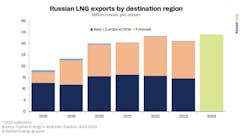Has the $5/Mcf US natural gas price floor threshold been crossed once and for all?
Some market-watchers see another price cycle looming on the horizon, beginning this year. No one is predicting another price collapse, or that even $3/Mcf is in the offing. But some analysts see ample storage and dwindling demand pulling prices back down to $4-4.50/Mcf in 2004-05. And yet a contrarian view holds that gas markets have accepted a $5/Mcf gas price floor through at least the midterm.
Price downturn?
The recent runup in US spot and futures gas prices reflects the waves of bitter cold that have swept across most of the northern half of the nation in December and January. Including the week ended Jan. 24, the US recorded 4 consecutive weeks of below-normal winter temperatures.
That was the main driver in front-month futures contract prices on the New York Mercantile Exchange peaking at $7.63/Mcf on Jan. 9.
However, it must be remembered that, for the heating season to date on Jan. 24, national heating degree days still were averaging 6% warmer than normal and 4% warmer than last year, notes Ron Barone with New York-based UBS Securities LLC. While mostly cold weather is expected to persist through mid-February, a comparison with last year's heavy withdrawals for the season to date suggests that US gas storage will end the heating season at a comfortable 1.244 tcf, he said in a recent research note. That level compares with end-season levels of 696 bcf in 2003, 1.5 tcf in 2002, and a prior 9 year average of 1.085 tcf. Consequently, and assuming more demand destruction and increased drilling activity, Barone projects a composite spot price for US gas dipping from $4.60/MMbtu in February-March to $4.40/MMbtu in April, $4.50/MMbtu for 2004, and $4/MMbtu in 2005.
Ohio petroleum economist and WRTG Energy Economics Ltd. Pres. James L. Williams concurs that a spot price below $5/MMbtu would be the norm, given that the spot price for the week ended Jan. 24 was 2¢/MMbtu below the btu-equivalent price for crude oil. "The current prices are not justified by either the above-normal storage level or the crude oil price," he said.
$5/MMbtu threshold
But regardless of current market physical fundamentals, is the market increasingly coming to accept the sustainability of a longer-term natural gas price floor around $5/MMbtu?
Jeffrey L. Mobley, an analyst with St. Petersburg, Fla., Raymond James & Associates Inc., seems to think so.
While NYMEX gas prices spiked to almost $8/Mcf in January and closed consistently above $6/Mcf during December-January, displaying extremely high volatility in the short term, the price level of the 12 month NYMEX strip displays a markedly low volatility, Mobley suggests in a recent research note. He pegged that volatility in January at 37%, below the historical norm of 39% and well below levels seen in prior price spikes. Noting that the 12 month NYMEX strip has recently approached $6/Mcf, among the highest levels of the past 4 years, there is a key difference with the latest price jump, says Mobley, in "that long-term prices have risen to such high levels in an orderly fashion without the dramatic volatility (i.e., lack of certainty) as experienced during previous price surges. "In our view, this is a strong indication of the market's acceptance of a sustainable price environment in excess of $5/Mcf."
Mobley also contends that the high degree of volatility in the front-month NYMEX contract represents just how tight the supply-demand balance is at present.
"This provides further support to our thesis of sustainably high commodity prices," he added. "Specifically, our gas price forecast calls for an average of $5.50/Mcf in 2004 and $5.75/Mcf in 2005."
So not only is RJA's price forecast considerably higher than what seems to be the consensus, but headed up, not down, in 2005.
If that view is correct, it would seem that the US natural gas market is entering a phase whereby the mere apprehension of long-term tightness in supply could be factored in as a separate and fixed price premium, much like the "war premium" (and perhaps even a "terrorism premium") has played a role in oil prices since the Iran-Iraq tanker wars of the 1980s.
Maybe it's already been with us awhile. After all, when was the last time somebody predicted even the remotest possibility of a price collapse to <$2/Mcf?

